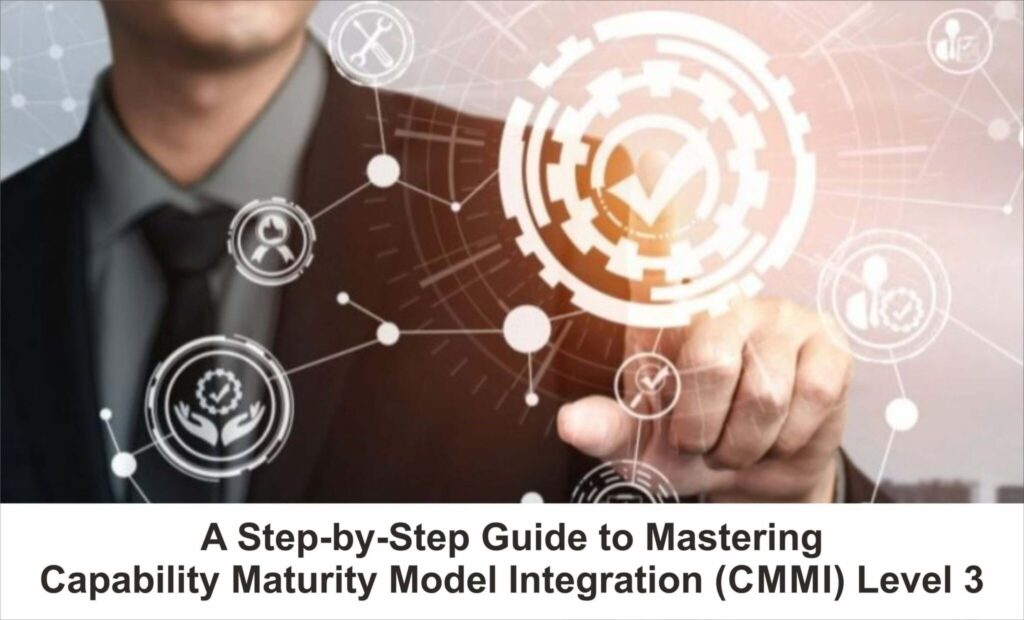A Step-by-Step Guide to Mastering Capability Maturity Model Integration (CMMI) Level 3

Obtaining CMMI (Capability Maturity Model Integration) Certification offers the optimal method for demonstrating a business’s reliability and dedication to its clients and customers! Information Technology (IT) Companies attribute success to producing high-quality products and adhering to a well-structured procedure that guarantees ongoing improvement. However, this is where the Capability Maturity Model Integration (CMMI) comes into the picture; it helps an organisation drastically improve its processes and systems by becoming CMMI Level 3 certified. CMMI Level 3 is the third level of the maturity model and is a critical achievement for businesses to demonstrate their commitment to providing high-quality goods and services. Obtaining this CMMI accreditation creates a positive and professional image for software and technology organisations. What is Capability Maturity Model Integration (CMMI) Certification? ⮯ CMMI (Capability Maturity Model Integration) is a widely known framework for process improvement that helps organisations improve business operations and security controls. It provides a comprehensive process roadmap to enhance the company’s performance and attain optimal results. Organisations that effectively implement well-defined business processes can achieve CMMI (Capability Maturity Model Integration) certifications. Organisations with CMMI certifications demonstrate their dedication, determination, effectiveness, and competence. They hold significant value and global recognition among customers and partners. What are the 5 Levels of Capability Maturity Model Integration (CMMI) Certification? ⮯ International organisations can get accredited by the CMMI Institute and receive CMMI certificates. Under the Capacity Level and Maturity Level, there are various certification levels. The first tiers till CMMI (Capability Maturity Model Integration) Level 3 within the CMMI group are listed here. Capability Maturity Model Integration (CMMI) Level 0: An organisation with capability level 0 has not yet established a well-thought-out practice area. Capability Maturity Model Integration (CMMI) Level 1: An organisation that has begun to improve its operations at the beginning level is represented by capability level 1. Capability Maturity Model Integration (CMMI) Level 2: An organisation that adheres to a straightforward but efficient practice area plan with well-defined procedures is represented by capability level 2. Capability Maturity Model Integration (CMMI) Level 3: Organisations that set end goals by adhering to established industry standards are at capability level 3. Maturity Levels Within Each Capability Maturity Model Integration (CMMI) ⮯ Maturity Level 0 denotes an organisation that has not yet successfully finished a project. The first maturity level, or Maturity Level 1, denotes an organisation that has not fulfilled its goals or deadlines. An organisation at Maturity Level 2 has unrelated tasks in the execution phase. A company at Maturity Level 3 employs a conventional strategy. This organisation meets deadlines while overcoming recurring problems. An organisation at Maturity Level 4 employs a data-driven strategy to achieve the project’s final objectives. An organisation at Maturity Level 5 has demonstrated ongoing improvement. It indicates that it has changed more quickly and effectively. Benefits of Capability Maturity Model Integration (CMMI) Level 3 Certification ⮯ Enhanced performance quality: An organisation with CMMI accreditation has established processes. It can deliver excellent results. Reliable delivery: Organisations with CMMI Level 3 certification include established and meticulously recorded protocols. It guarantees consistent and dependable product and service delivery. Lower risk:Capability Maturity Model Integration (CMMI) Level 3 certified businesses have established proactive measures to manage risks. As a result, clients feel more confident in their ability to provide the intended results. Boost productivity: Businesses must streamline their workflow and operational procedures to receive this accreditation. It enhances overall productivity. Conclusion ✅ A carefully thought-out and implemented process improvement strategy that includes gap analysis, implementation, and formal assessment is necessary to achieve certification. Nonetheless, the advantages of obtaining CMMI (Capability Maturity Model Integration) Level 3 certification, like enhanced productivity, superior quality, and a competitive edge, make the effort valuable. Success in the software development business will largely depend on an organisation’s ability to change and adapt to shifting industry norms and customer expectations. In this regard, CMMI Level 3 accreditation will be essential. Tags
